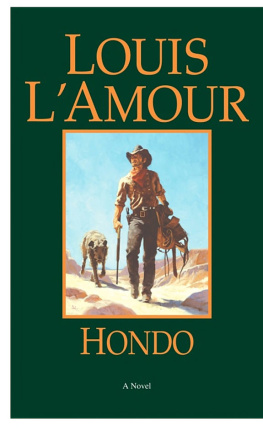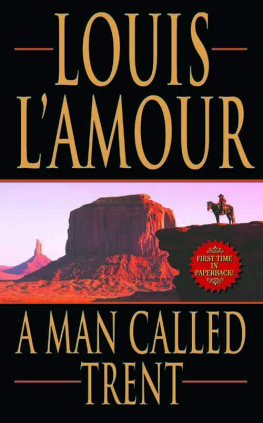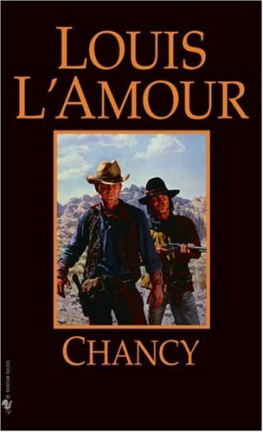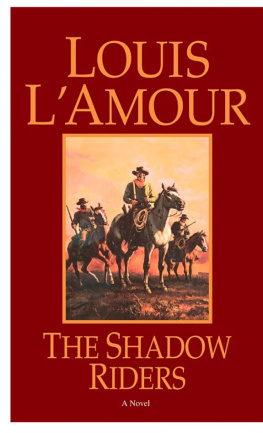Louis LAmour - The Sackett Companion: A Personal Guide to the Sackett Novels
Here you can read online Louis LAmour - The Sackett Companion: A Personal Guide to the Sackett Novels full text of the book (entire story) in english for free. Download pdf and epub, get meaning, cover and reviews about this ebook. year: 1988, publisher: Bantam, genre: Home and family. Description of the work, (preface) as well as reviews are available. Best literature library LitArk.com created for fans of good reading and offers a wide selection of genres:
Romance novel
Science fiction
Adventure
Detective
Science
History
Home and family
Prose
Art
Politics
Computer
Non-fiction
Religion
Business
Children
Humor
Choose a favorite category and find really read worthwhile books. Enjoy immersion in the world of imagination, feel the emotions of the characters or learn something new for yourself, make an fascinating discovery.

- Book:The Sackett Companion: A Personal Guide to the Sackett Novels
- Author:
- Publisher:Bantam
- Genre:
- Year:1988
- Rating:4 / 5
- Favourites:Add to favourites
- Your mark:
- 80
- 1
- 2
- 3
- 4
- 5
The Sackett Companion: A Personal Guide to the Sackett Novels: summary, description and annotation
We offer to read an annotation, description, summary or preface (depends on what the author of the book "The Sackett Companion: A Personal Guide to the Sackett Novels" wrote himself). If you haven't found the necessary information about the book — write in the comments, we will try to find it.
The Sackett Companion: A Personal Guide to the Sackett Novels — read online for free the complete book (whole text) full work
Below is the text of the book, divided by pages. System saving the place of the last page read, allows you to conveniently read the book "The Sackett Companion: A Personal Guide to the Sackett Novels" online for free, without having to search again every time where you left off. Put a bookmark, and you can go to the page where you finished reading at any time.
Font size:
Interval:
Bookmark:

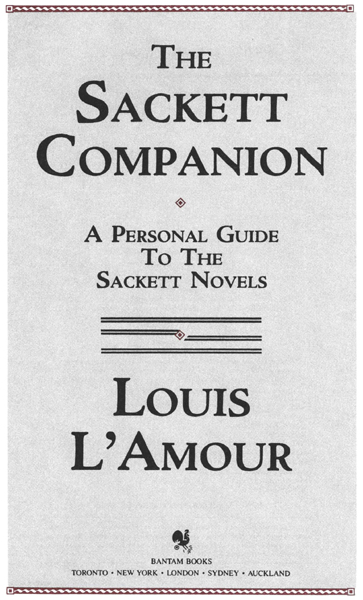
THE SACKETT COMPANION
A Bantam Book / November 1988
Produced by Ink Projects
Maps by William B. and Alan McKnight:
Sacketts Land. To The Far Blue Mountains, Lando, Mustang Man.
The Lonely Men, Treaure Mountain, and The Sackett Brand.
All other maps by Alan McKnight.
All rights reserved.
Copyright 1988 by Louis LAmour.
No part of this book may be reproduced or transmitted in any form or by any means, electronic or mechanical, including photocopying, recording, or by any information storage and retrieval system, without permission in writing from the publisher.
For information address: Bantam Books.
Library of Congress Cataloging-in-Publication Data
LAmour, Louis, 19081988
The Sackett companion.
1. LAmour, Louis, 19081988Handbooks, manuals, etc. 2. LAmour, Louis, 19081988CharactersSackett family. 3. Western storiesHandbooks, manuals, etc. 4. Sackett family (Fictitious characters)Handbooks, manuals, etc. I. Title.
PS3523.A446Z459 1988 813.52 88-47530
eISBN: 978-0-307-49038-4
Bantam Books are published by Bantam Books, a division of Random House, Inc. Its trademark, consisting of the words Bantam Books and the portrayal of a rooster, is Registered in U.S. Patent and Trademark Office and in other countries. Marca Registrada. Bantam Books, 1540 Broadway, New York, New York 10036.
v3.1

Louis LAmour died on June 10, 1988. He completed the manuscript for THE SACKETT COMPANION some months before his death, and throughout it he refers to future stories and characters whose tales were still to be told. Rather than delete these references, we felt his many readers would be interested in knowing what he hoped to write.

A question I am often asked is: How long does it take to write a book?
It seems to me a ridiculous question. If the questioner stopped to think, he or she would understand that it takes as long as is necessary. Is the book to be two hundred pages or two thousand? Is much research required or very little? No book can be written without some research, for no matter how much one believes he knows, it will always prove to be less than enough.
I rarely do research on a book I am writing. That research has, except for the unexpected detail, been done long before. By the time I begin to write, I am saturated with the background of my story. Yet one never knows enough. There is always more to be learned.
Another question I am asked at least once a month or during the question-and-answer period at a lecture: What book can I read to learn about the West?
What part of the West? During what period? What phase of western settlement?
I have read, scanned, or browsed through literally thousands of books, documents, diaries, and reports and am only beginning to understand what happened; how, why, when, and where it happened; to say nothing of all the problems and influences that contributed to what the West was at various stages in history.
No story of the frontier can be written without knowledge of the physical environment, of the terrain, vegetation, animal, and insect life. Each state differs from every other, and within each state there are many widely diverse environments. Montana is unlike Texas, and both differ in many respects from Arizona, New Mexico, Nevada, or Colorado.
The Plains states present other problems, as do those rimming the Pacific. Oddly enough, some readers have never realized that California was as much a cowboy state as any other, and her vaqueros were among the greatest riders and ropers this country ever saw. It was second in cattle population only to Texas.
Oregon, Washington, and Idaho had their big ranches, their stagecoach hold-ups, and gunfighters, so the West was and is a very large area, indeed.
To really know the western frontier requires a lifetime of study. And there will always be those unexpected pockets of history that have developed in relative isolation so far as the reading public is concerned.
The western American frontier went through many phases of development. The Spanish who settled in the Southwest and the French in the North and Northwest were the first. Then the so-called Long Hunters (because they were out a long, long time!) ventured west of the Appalachians. Daniel Boone, who is considered by many to be the original western pioneer, was, in fact, preceded by many others. Gabriel Arthur was living with the same Indians Boone was to meet, but one hundred years earlier, and he was but one of many.
Our histories are based largely upon official or semi-official reports that appeared at a time when only a small number of people could read and write. Few of the hunters and explorers even thought of writing what had happened to them or where they had been. In our western histories, and indeed, in the history of the world, we are basing all our conjectures on only a small number of accounts. Moreover, most of these come from a relatively few countries; reports from elsewhere in the world are rarely considered.
At a rough guess, I would estimate that ninety percent of the fiction written about the West has concerned the Plains states or those few others that were in the cattle business or provided a trail westward that moved from Missouri to California. For some reason the man on horseback has always intrigued, whether he be knight in armor, a Bedouin of the desert, or an American cowboy. He has always been a figure of romance.
Is it because he is mobile? Because he can ride away into the sunset? Or that he comes from out of nowhere, a mysterious, romantic figure who appears without warning and is seemingly free of everyday trials and troubles?
Contemporary man has tried to substitute the car for the cow pony, but it simply doesnt work. True, in a car he is mobile, and once behind the wheel he can feel the excitement of command, but nevertheless the car is bound to the road, inhibited by traffic, and frustrated by regulations essential to his safety but which he often feels rob him of the true freedom he wants.

To write well of the West there is so much one should know. Horses, cattle, weapons, the way a saddle was rigged, the way a cowhand used a rope, and the lifestyles of Indians varied greatly from place to place.
The English saddle, for instance, was intended for the hunt or for brief rides, but a cowhand lived in his saddle from daylight until dark. It was not only where he spent a major part of his life, it was his workbench, and had to be structured as such. The ancestor of the cowboy saddle was that of the armored knight who needed a secure seat, or the Conquistador who followed Cortes, Coronado, and their kind. These men established settlements in New Mexico, with churches and schools, long before the Pilgrims landed in 1620.
As for the importance of physical environment: the land itself was always present in the thoughts, the emotions, and calculations of the pioneer. No story of the West can be written where the terrain is not a factor. The distance from here to there, the existence of waterholes, the condition of the grass, the trails (if any existed), and many other factors had to be considered. The country demanded consideration in any pioneers plans, but it also exerted its influences on the emotions. Many simply could not stand the rolling plains that seemed to go on forever with a vast sky arching overhead. Many turned and ran for cover in city streets or small villages where they had lived. Some went insane from the ever-blowing wind and the isolation of life on a government claim.
Font size:
Interval:
Bookmark:
Similar books «The Sackett Companion: A Personal Guide to the Sackett Novels»
Look at similar books to The Sackett Companion: A Personal Guide to the Sackett Novels. We have selected literature similar in name and meaning in the hope of providing readers with more options to find new, interesting, not yet read works.
Discussion, reviews of the book The Sackett Companion: A Personal Guide to the Sackett Novels and just readers' own opinions. Leave your comments, write what you think about the work, its meaning or the main characters. Specify what exactly you liked and what you didn't like, and why you think so.

